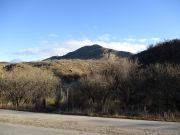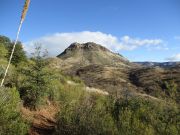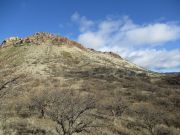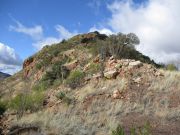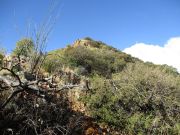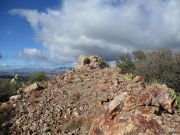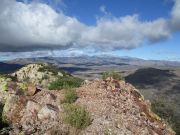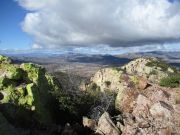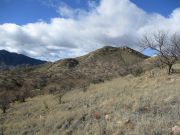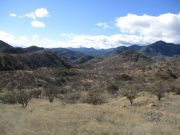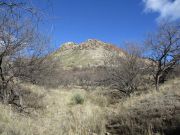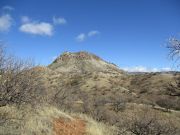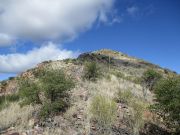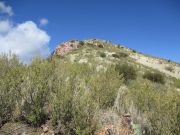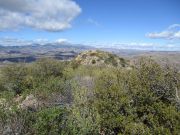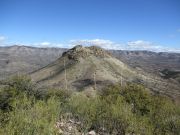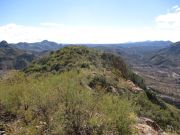
The Mountains of Arizona
www.surgent.net |
|
Kunde Mountain • Peak 5219 Kunde Mountain rises a couple miles southeast of Patagonia, in Santa Cruz County. From the town, it can be seen peeking above a foreground peak, Peak 5219, which I would also climb. I've done very little climbing or hiking in the Patagonia Mountains, my last time (and I think my only time) being in October 2010, when I climbed Red Mountain Lookout. Getting to the peaks is simple, as paved Harshaw Road runs below them to the west, and a connector trail to the Arizona Trail begins at a trailhead just inside the Coronado National Forest boundary. However, neither peak has a trail to its summit. I would be obliged to go off trail to tag each peak's top. I was on the road out of Bisbee at 6:30 a.m., dawn just breaking. I stopped in Sierra Vista for gas and snacks, then followed AZ-90 to Whetstone, then AZ-82 to Patagonia, about a 70-mile drive from Bisbee. We'd had three days of rain and clouds, and today would be the first day after the storm had cleared out. It was mostly clear for now, but clouds still shrouded the bigger peaks, which were covered in snow down to about the 7,000-foot level. It was cold, in the 30s, but moist. In Patagonia, I followed a connector to Harshaw Road, then a couple miles later, pulled into the parking lot for the trailhead. One other car was there, a camper-van. I got suited up and prepared, locked up my car, and started walking at 8:40 a.m..
Date: February 3, 2024
• Elevation: 5,373 feet
• Prominence: 763 feet
• Distance: 7.5 miles
• Time: 5 hours, 40 minutes entire hike
• Gain: 1,660 feet (gross)
• Conditions: Cold, sunny with puffy clouds, breezy
Arizona
•
Main
•
PB
•
LoJ
I crossed thr road and got onto the connector trail. Immediately, it was muddy. This initial portion runs along a creek and looks marshy for this little segment. The mud was heavy and sticky, as well as slick. I pushed through it and out of the muck as the trail gained elevation and became a more normal rocky trail.
For now, Peak 5219 is visible, and the trail would eventually gain a saddle on its south ridge, about a mile in from the road. The trail is a good trail and would gain a few dozen feet, then lose them all dropping into drainages. I passed one gate early on. Finally, the trail starts to gain elevation earnestly, achieving an apex on the southern ridge of Peak 5219. Then it dropped again, about 60 feet, before gaining steeply once more, topping out on a south-eastern ridge of Peak 5219. I passed through a second gate here, and now could see Kunde Mountain. My plan was to climb Kunde Mountain first, then climb Peak 5219 on the hike out.
The trail drops yet again, about 120 feet, now weaving through bluffs and small canyons. The trail would gain onto high ground where I could get a good look at Kunde's slopes, then drop again into a drainage. This went on a few times. I needed to "sense" when would be a good time to leave the trail. If I left it too early, I'd be going into and out of drainages to get onto the right slope, wasting time and energy.
Kunde Mountain has grass-covered slopes that rise steeply below a rocky crown of cliffs and outcrops. From below, it looks like there are no good lines to approach its summit. The map shows a track that allegedly goes to the top, but past visitors mentioned that there is no such track, at least down low where it should cross the trail. However, higher up, traces of this track still exist and it does offer a messy "trail" to the very top. It's not visible on the satellite images, but the 1-meter Lidar "hillshade" maps show this track.
I left the trail and started up through the easier lower slopes of grass and mesquite trees. There was very little cactus, mainly pencil cholla, and there were clumps of ocotillo. I could usually keep to a brush-and-branch-free route as long as I zig-zagged enough.
I had gained about 150 feet from the trail and was now on more open slope, high enough to get a better sense of the surroundings. At the far end of the summit ridge is a point of rock, and coming off that what looked like a straight line, too straight to be natural. That had to be the road. It came toward me, then made a hard turn and went the other way. I could barely make it out against the grassy slope. Only the low light and shadows helped me distinguish it.
The slopes started to steepen as I aimed generally for the road. I had to cross a fence line, shimmying underneath it. Despite the slightly-wet muddy ground, I was able to keep from getting too dirty. Now I was on the steep slopes. I picked a line and started walking directly uphill. I would sense a path sometimes, a few going laterally, probably animal paths. I followed what I could, mainly up and sometimes over. This was tiring. Where is that road?
Finally, I could see a "lip" of grass and rocks where the ancient road berm was put in. I eased up the rocks and was on this peculiar road. Looking down, I could not see anything that looked like a road, not even remotely. No hints whatsoever. I started walking the road uphill, dodging fully-grown plants and small trees growing in its tread. The road made one right bend and aimed for that point mentioned earlier. It was a scant road at best, but it worked. It got me to that point.
Here, the road makes a sharp left bend. Looking up, it was about another 200 feet of a jumble of rocks and brush. The "road" by now was just a mush of rocks and dead trees lying across it. It then cut across a slope with steep drops below, made a sharp left bend up a switchback, then a right bend, now on the highest summit ridge. Much to my surprise, this road led right to the top. It ends on a platform beside the summit rocks.
The summit was open and I had good views. A second summit rose a few hundred feet north but it was obviously lower by about ten feet, which was a relief because I was not keen to hike to it. I clambered onto the rocks and tagged the highest points, then found the register buried in a cairn in a crevice, and signed in. Names in the old log went back to the 1980s, about a dozen visitors a year.
I snapped some photos, including that of the snow-bound Santa Ritas to the north, and Red Mountain Lookout to the west, with Peak 5219 rising in between. The clouds were puffy and moved through quickly. I would have spells of bright sun then heavy clouds, temperatures staying in the 40s. I had a snack but did not stay long, the breeze chilling me.
I hiked back down the road to where I had met it coming up, then basically retraced my route, even shimmying under the fence at the exact same spot. For about fifteen minutes I could hear some cow mooing and groaning, like it was agitated. It was a cow having a cow. I never saw it. It didn't sound injured, just probably confused as they usually are.
I was back into the lower slopes, bluffs and drainages, planning to intersect the trail, but i tended to move more across than down mainly because it was easy to do so, and as a result, I caught the trail much closer to Peak 5219 than when I had left it.
The road was a curiosity because this peak looks unamenable to having a road put in, with its very steep slopes and rocky crown. I did not see anything that looked like a mine, and since the road went literally to the very top, I wondered if it was put in for a lookout tower, which would make sense. But I cannot verify that and I found no such references on the internet, nor did I see anything that looked like a lookout tower once stood here. No footings or other junk. Just a flat platform of rock. Whoever put it in had some cojones. I can imagine some guys in the 1940s amped up on nicotine, cholesterol, whiskey, inspired by pinups of dames, blasting in and using heavy machinery to hew in this road, all because some guy in Tucson told them to. Also, down low, I saw nothing to suggest an old road, such as berms or flattish platforms. The lower road has been completely erased. Needless to say, it will never see a vehicle again.
Elevation: 5,219 feet ✳
• Prominence: 449 feet
• Distance: 1.2 miles
• Gain: 644 feet
• Conditions: Same
PB
•
LoJ
•
Lidar
On the hike in, I had studied both ridges that lead north to the summit of Peak 5219. The higher ridge is to the southeast and has the gate I mentioned earlier. But looking up, it appeared to get very steep at the end. The more southerly ridge appeared to have a more consistent slope, but with more rocks and sloppy cliffs. I chose to go with the south ridge. From the gate, I dropped about 60 feet, then up about 40, where the trail apexes momentarily before starting back down toward the trailhead.
I left the trail and started through the low brush and rocky terrain, the gradient lenient for now. I "sensed" some paths and it would not surprise me a few people have busted ways up this peak in the past. The first challenge comes quick: a rock headwall about 25 feet tall in places, a mess of broken cliffs, chutes and random rocks laying about. I angled right and inched up the steep slope through ocotillo and bushes, curling around the end of this rocky barrier. I then made a sharp left and busted steeply up more loose rocky slope to top out on the ridge again. Looking up, it all looked friendly, and it would turn out that this little segment may have been the crux of the short climb.
Staying on the ridge, it was rocky but open, and the rocks usually piled in ways to allow for easy clambering, high stepping and maybe using the hands once or twice. I sometimes found a path that dropped to one side a few feet, but always returned to the ridge when it felt right. Shortly, I was on the home stretch, the final hundred vertical feet up through a slope of random rock outcrops and more small cliffs.
I was able to find ways around or through the rocks that involved nothing more than steep walking, with hands for balance. I was at the base of one final cliff. I scampered up a sloppy slope into a chute, then found a ledge that ran a few feet and topped out above the cliff. Other than to place my hands on rocks for balance, I would not call this scrambling. The ledge was a fortuitous find.
To my surprise, I was feet from the southern summit, a tall agave stalk sprouting very near the top. The peak has two summits, the map showing a 5,213-foot spot elevation on its southern lobe, and nothing on its northern lobe. Checking the 1-meter Lidar dataset prior to the climb, it showed a 5,214-foot elevation for this southern lobe, and a 5,219-foot elevation for the northern lobe. The southern summit area was brushy, and hard to sight from the southern rocks to the northern rocks due to the brush. Just by visual sense alone, the northern lobe looked slightly higher.
I had intended to hike to it anyway. The drop was trivial, about 15 feet, then up about 20 feet to the northern summit, which was rocky too, but bare. I found nothing here, no cairns or registers. I snapped a couple of photos, and tried to sight back to the southern summit, but not surprisingly, saw just a lot of brush. I hiked back to the southern summit and took a longer break on its rocks, which were ideal for sitting. I looked for a register here as well, with no luck.
The southern summit has some rocks angled as if they were dropped onto the top, so it's possible the tippy-top of one of these rocks might add a foot or two to the summit figure, perhaps Lidar not picking it up. Even then, the north summit still looked higher.
Hiking down was fun and went fast. I stuck to the high ridge until I was above that lower cliff band, then eased down its slopes and around back to the lower ridge, back to the trail. This side trip took about an hour, covering 1.2 miles round trip and over 660 feet of gain. It was a worthy peak and I am happy I added it on to today's agenda.
I hiked out the remaining mile-plus back to my car, arriving a little after 1 p.m.. A young couple were parked in the lot, gearing up for what looked like a multi-day pack on the Arizona Trail. I didn't change, just threw my stuff into the back seat, and drove out, stopping for groceries in Sierra Vista, then home by 3 p.m..
|
|
